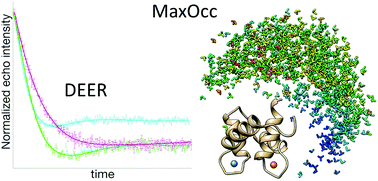Assessing protein conformational landscapes: integration of DEER data in Maximum Occurrence analysis†
Abstract
The properties of the conformational landscape of a biomolecule are of capital importance to understand its function. It is widely accepted that a statistical ensemble is far more representative than a single structure, especially for proteins with disordered regions. While experimental data provide the most important handle on the conformational variability that the system is experiencing, they usually report on either time or ensemble averages. Since the available conformations largely outnumber the (independent) available experimental data, the latter can be equally well reproduced by a variety of ensembles. We have proposed the Maximum Occurrence (MaxOcc) approach to provide an upper bound of the statistical weight of each conformation. This method is expected to converge towards the true statistical weights by increasing the number of independent experimental datasets. In this paper we explore the ability of DEER (Double Electron Electron Resonance) data, which report on the distance distribution between two spin labels attached to a biomolecule, to restrain the MaxOcc values and its complementarity to previously introduced experimental techniques such as NMR and Small-Angle X-ray Scattering. We here present the case of Ca2+ bound calmodulin (CaM) as a test case and show that DEER data impose a sizeable reduction of the conformational space described by high MaxOcc conformations.



 Please wait while we load your content...
Please wait while we load your content...